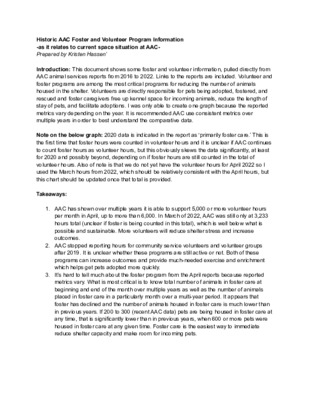4a Volunteer Foster Data Hassen — original pdf
Backup

Historic AAC Foster and Volunteer Program Information -as it relates to current space situation at AAC- Prepared by Kristen Hassen’ Introduction: This document shows some foster and volunteer information, pulled directly from AAC animal services reports from 2016 to 2022. Links to the reports are included. Volunteer and foster programs are among the most critical programs for reducing the number of animals housed in the shelter. Volunteers are directly responsible for pets being adopted, fostered, and rescued and foster caregivers free up kennel space for incoming animals, reduce the length of stay of pets, and facilitate adoptions. I was only able to create one graph because the reported metrics vary depending on the year. It is recommended AAC use consistent metrics over multiple years in order to best understand the comparative data. Note on the below graph: 2020 data is indicated in the report as ‘primarily foster care.’ This is the first time that foster hours were counted in volunteer hours and it is unclear if AAC continues to count foster hours as volunteer hours, but this obviously skews the data significantly, at least for 2020 and possibly beyond, depending on if foster hours are still counted in the total of volunteer hours. Also of note is that we do not yet have the volunteer hours for April 2022 so I used the March hours from 2022, which should be relatively consistent with the April hours, but this chart should be updated once that total is provided. Takeaways: 1. AAC has shown over multiple years it is able to support 5,000 or more volunteer hours per month in April, up to more than 6,000. In March of 2022, AAC was still only at 3,233 hours total (unclear if foster is being counted in this total), which is well below what is possible and sustainable. More volunteers will reduce shelter stress and increase outcomes. 2. AAC stopped reporting hours for community service volunteers and volunteer groups 3. after 2019. It is unclear whether these programs are still active or not. Both of these programs can increase outcomes and provide much-needed exercise and enrichment which helps get pets adopted more quickly. It’s hard to tell much about the foster program from the April reports because reported metrics vary. What is most critical is to know total number of animals in foster care at beginning and end of the month over multiple years as well as the number of animals placed in foster care in a particularly month over a multi-year period. It appears that foster has declined and the number of animals housed in foster care is much lower than in previous years. If 200 to 300 (recent AAC data) pets are being housed in foster care at any time, that is significantly lower than in previous years, when 600 or more pets were housed in foster care at any given time. Foster care is the easiest way to immediate reduce shelter capacity and make room for incoming pets. ● 496 volunteers served 4,257 hours and 13 volunteer groups served 363 hours. 10 community service volunteers served 114 hours. ● 9 volunteer info sessions were held and eight were scheduled for May. ● 152 foster applications processed ● 620 approved foster families and 406 animals housed in 213 foster homes. April 2016 April 2017 ● 393 volunteers donated 5,769 hours of service and 33 volunteer groups gave 701 hours of service. 15 community service volunteers gave 99.5 hours. ● 10 new volunteer information sessions were held. ● 429 animals were placed in foster homes. ● 183 families fostered pets and 75 new applications were processed. ● There were 1,044 approved, active foster caregivers. ● NOTE: In NEWS Section, the report states: “The center inventory has remained at its lowest in history with an average of 600 pets in the care of AAC in April.” This is significant because in March the inventory at AAC (between foster and shelter) was reported to be at 600 and AAC was asserting the shelter was “critically, dangerously full.” ● 361 volunteers donated 4,558 hours of service. Eight volunteer groups donated 146 hours. Eight community service volunteers contributed 157 hours. ● Six new volunteer orientations were held. ● 188 families provided foster care. ● There were 598 active foster caregivers registered and 72 new foster applications were April 2018 processed. April 2019 ● 379 volunteers donated 5,015 hours of service. 15 groups donated 306 hours. 20 community service volunteers contributed 211 hours. ● Six new volunteer orientations were held. ● 316 families fostered pets. ● 1,155 approved foster caregivers in GivePulse ● 82 foster applications were processed April 2020 ● 60 volunteers donated 1,958 hours, primarily as fosters. (CHANGE TO COUNTING FOSTER AS VOLUNTEER HOURS). ● 420 families provided foster care ● There are 1,758 approved foster caregivers and 1,548 applications were processed. ● There were 394 animals in 329 foster homes. April 2021 (NO REPORT FOUND for Jan through April 2021). May of 2021 ● 79 volunteers donated 1,291 hours during May ● 200 families provided foster care ● 1,073 approved foster caregivers and 79 new applications processed April 2022 - No report as of 4/9 online March 2022 ● 260 volunteers gave 3,233 hours of volunteer service ● Six orientations were held in March ● 140 families provided foster care ● 112 new foster applications processed ● There are 764 active foster caregivers ● 192 pets were in foster care on April 1